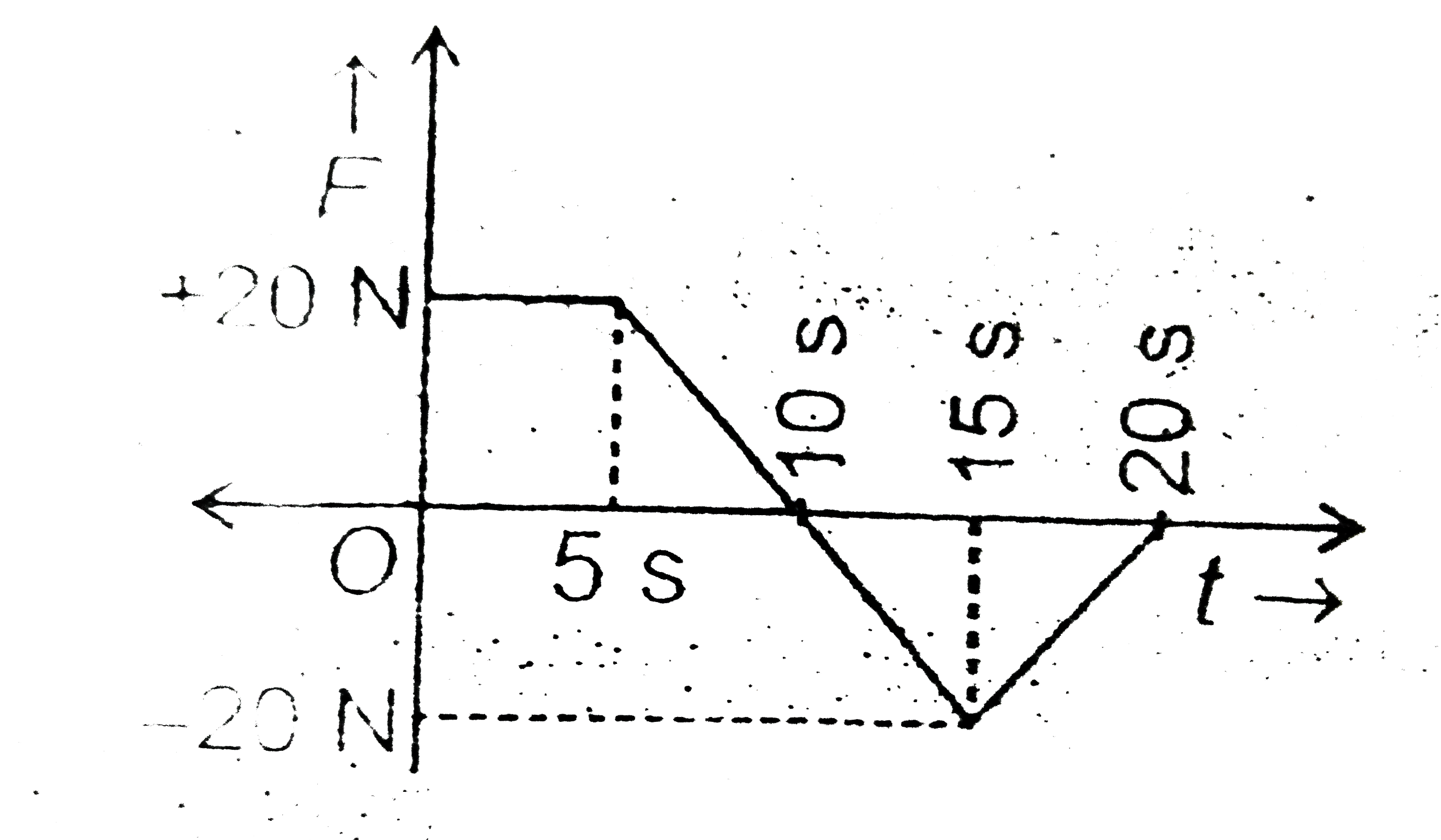A body of mass 5 kg starts from the origin with an initial velocity u→ = 30 i + 40 j ms–1. If a constant Force F = – i ̂ + 5jN acts on the body the time in which the y-component of the velocity becomes zero is A 5 s B 20 s C 40 s D 80 s
Correct option: C 40 sExplanation: m = 5 kgu = 30 i˄ + 40 j m/s hence uy = 40 m/sF = – i + 5jN hence Fy = – 5NF = maa = F / may = Fy / m= – 5 / 5ay = – 1 m/s2 Vy = uy + atvelocity vy becomes zeroo = uy + atuy = – at{40 / –– 1} = tt = 40 sec
Related Solutions
A body of mass 5 kg statrs from the origin with an initial velocity vec(u) = (30 hat(i) + 40 hat(j)) ms^(-1) . If a constant force (-6 hat(i) - 5 hat(j))N acts on the body, the time in which the y component of the velocity becomes zero is
View SolutionA body of mass 5 kg statrs from the origin with an initial velocity vec(u) = (30 hat(i) + 40 hat(j)) ms^(-1) . If a constant force (-6 hat(i) - 5 hat(j))N acts on the body, the time in which they component of the velocity becomes zero is
View SolutionA body of mass 5 kg statrs from the origin with an initial velocity . If a constant force acts on the body, the time in which they component of the velocity becomes zero is
View SolutionA body of mass 5 kg starts from the origin with an initial velocity u = ( 30 hati + 40 hatj ) ms ^(-1) . If a constant force (- 6 hati - 5 hatj ) N acts on the body, the time (in seconds) in which they component of the velocity becomes zero is
View SolutionA body of mass 5 kg starts from the origin with an initial velocity . If a constant force acts on the body, the time in which the y-component of the velocity becomes zero is
View SolutionA body of mass 5kg starts from the origin with an initial velocity of . A constant force of acts on the body . Find the time in which they- component of the velocity becomes zero .
View SolutionA body of mass 5 kg starts from the origin with an initial velocity of vecU=(30i+40j)m//s .A constant force of F=(-hati-5hatj)N act on the body . Find the time in which the y-component of the velocity become zero .
View SolutionA body of mass 5 kg starts from the origin with an initial velocity bar(u)=(30hati+40hatj)ms^(-1) .If a constant force (-6hati-5hatj)N acts on the body, the time in velocity, which the y-component of the velocity becomes zero is.
View SolutionA body of mass 5 kg starts from the origin with an initial velocity bar(u)=(30hati+40hatj)ms^(-1) .If a constant force (-6hati-5hatj)N acts on the body, the time in velocity, which the y-component of the velocity becomes zero is.
View SolutionA body of mass 5 kg starts from the origin with an initial velocity . If a constant force acts on the body, the time in which the y-component of the velocity becomes zero is
View SolutionA body of mass 5kg starts from the origin with an initial velocity vecu = 30 hati + 40 hatj ms^(-1) . If a constant force vecF = -(hati + 5hatj) acts on the body, the time in which the y-component of the velocity becomes zero is :
View SolutionA force N acts on body of mass 5 kg. If the body starts from rest, its position vector at time t = 10 s, will be
View SolutionA body of mass 5 kg stJrls from the origin with an initial velocity bar(u)=(30hati+40hatj)ms^(-1) .If a constant force (-6hati-5hatj)N acts on the body, the time in velocity, which the y-component of the velocity becomes zero is.
View SolutionA body of mass 5kg starts from the origin with an initial velocity . If a constant force acts on the body, the time in which the y-component of the velocity becomes zero is
View SolutionA body of mass 5kg starts from the origin with an initial velocity of barU= (30i+40j)m//s . A constant force of F= (-hati - 5 hatj)N acts on the body . Find the time in which they- component of the velocity becomes zero .
View SolutionA body of mass 5kg starts from the origin with an initial velocity of barU= (30i+40j)m//s . A constant force of F= (-hati - 5 hatj)N acts on the body . Find the time in which they- component of the velocity becomes zero .
View SolutionA body of mass 2 kg starts with an intitial-velocity 5 m/s. It the body is acted upon by a time dependent force (F) as shown in figure, then work done on the body in 20 s is
View SolutionA body of mass 2 kg starts with an intitial-velocity 5 m/s. It the body is acted upon by a time dependent force (F) as shown in figure, then work done on the body in 20 s is
A. − 875 J
B. 875J
C. 600J
D. − 600 N J
 View Solution
View SolutionA body of mass 5 kg starts from the origin with an intial with an intial velocity . If the body collides with a wall and after collision its velocity becomes then what is change in momentum of body ?
View SolutionA body of mass 5 kg starts from the origin with an intial with an intial velocity vec (u) = 30hat(i) + 40hat(j). . If the body collides with a wall and after collision its velocity becomes vec(v) = - 30 hat (i) + 40 hat (j) , then what is change in momentum of body ?
View Solution
